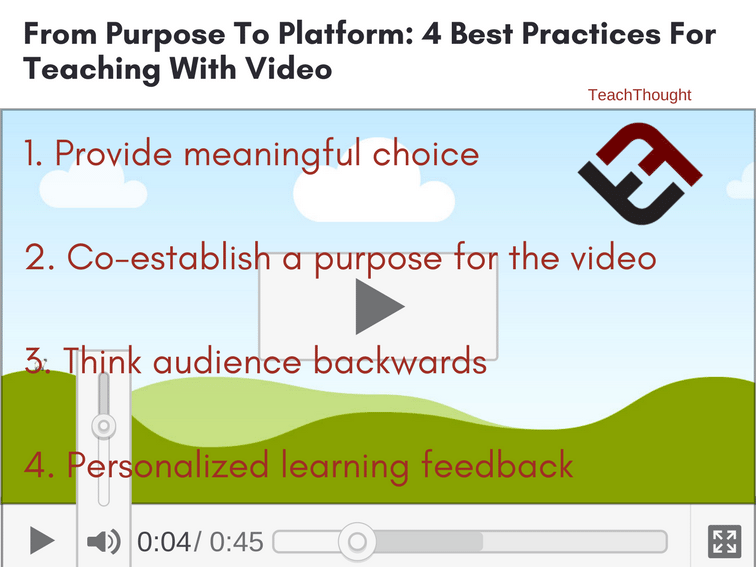
From Purpose To Platform: 4 Best Practices In Teaching With Video
contributed by Brian Lamb and Emily Merritt, letsrecap.com
Video can be a powerful strategy and best practices in teaching and learning.
In the last 10 years, we’ve seen it revolutionize instruction (Khan academy, MOOC’s), creative class projects (iMovie), teacher video coaching (Swivl), assessment and now it’s starting to change moderated education discussions for exploring topics and checking for understanding.
Video is an ideal outlet for creativity. For capturing what actually happened in an objective manner. For communicating with clarity and emotion, including intent, and for practicing speaking skills. All unequivocally great things.
But as we continue to discover video’s full potential, and more and more people use it, we’re also seeing that some things about video don’t change. Without the right conditions, it still makes most people uncomfortable to be on camera. They often resist or hesitate to start recording when asked–even younger generations. And this makes it clear why the most dominant video app on the planet is built on the condition that content disappears to reduce this tension (Snapchat).
See also 40 Viewing Comprehension Strategies: Watching Videos Like You Read A Book
Inhibiting discussion is at cross purposes with our goals. So this is something we’ve been wary about. Something that we’ve also been wary of is that video can be used to change behaviors. And not in a good way. It can be used to control behavior. To force it. Uncle Ben was right, the power of video requires it be used responsibly, especially as we start to use video in moderated educational discussions where participation can be required.
We channeled these concerns and all our prior experience with evolving Recap to include chat-based question and response tools that are augmented by video instead of a video-only experience. Communicating effectively through chat to develop understanding is both highly effective and is becoming an essential 21st-century skill.
We think merging the two can create more than the sum of parts. Chat makes conversations easy to start and can help using video become more authentic and less forced.
From Purpose To Platform: 4 Best Practices In Teaching With Video
1. Provide Meaningful Choice.
Participants need to have a choice in when they use video–compelling choices about aspects of the video and its creation that actually matter to them.
Aspects of the video’s creation that are required, or worse graded, can inadvertently force specific please-the-teacher behavior unnaturally.
Provide lessons, feedback, and options for:
-how to communicate (text or video) and how to use video with social media or video and comments or how to title the video, etc.
-what to communicate on (options for different questions or even questions suggested by participants themselves)
-when to use video–or to release and socialize the video
-where to publish the video (if it should be published) and what platforms to publish it on and how the video should change depending on the platform
-why to use video based on its strengths and weaknesses as a medium
These kinds of choices are critical to student ownership of work, and the long-term impact of the video on the learning of the student (e.g., making it part of a digital portfolio, using it in their personal life, etc.).
2. Co-establish an Authentic Purpose or Need For the Video.
What is the purpose of the video? What would it ideally ‘do’? How would you know that it ‘worked’?
Given the context of the dialogue and what you have to say, does it feel like the best way to express yourself? Is clarity of your intent essential to what is being said?
Is there an emotional context required (enthusiasm, excitement, concern, etc)? Or do you need to demonstrate something that video uniquely enables?
If the answers to you or participants is yes, then video is a great tool for this. If not, then maybe looking at written responses is better to promote discussion.
3. Think Audience Backwards.
According to Maslow’s Heirarchy, ‘safety’ is among the highest if human needs.
Students need to feel psychological and emotionally and creatively ‘safe’ when using video, and a is part of this is who the video is being created for, who can save and share it socially, who can view it, who can comment on it (YouTube allows comments to be turned on or off on videos for a reason).
For you as a teacher, this means that the audience needs to ‘feel’ like the the right audience. Depending on circumstances, it can mean one person or the whole world.
Helping the students understand the audience of then video should be part of the planning right away–at the very beginning of the planning process. Make sure audience awareness fits the circumstances and your participants needs, and that they understand–in terms of tone, content, length, style, etc–that audience’s needs.
4. Provide Personalized Feedback.
When you request the use of video, make sure you have time watch everyone’s response. And moreover, seek to empower them by meaningfully responding to what they say in words and in follow up actions.
Not only is personalized feedback useful to motivate students, it’s also one of the most powerful ways to help them improve their work and grow.
